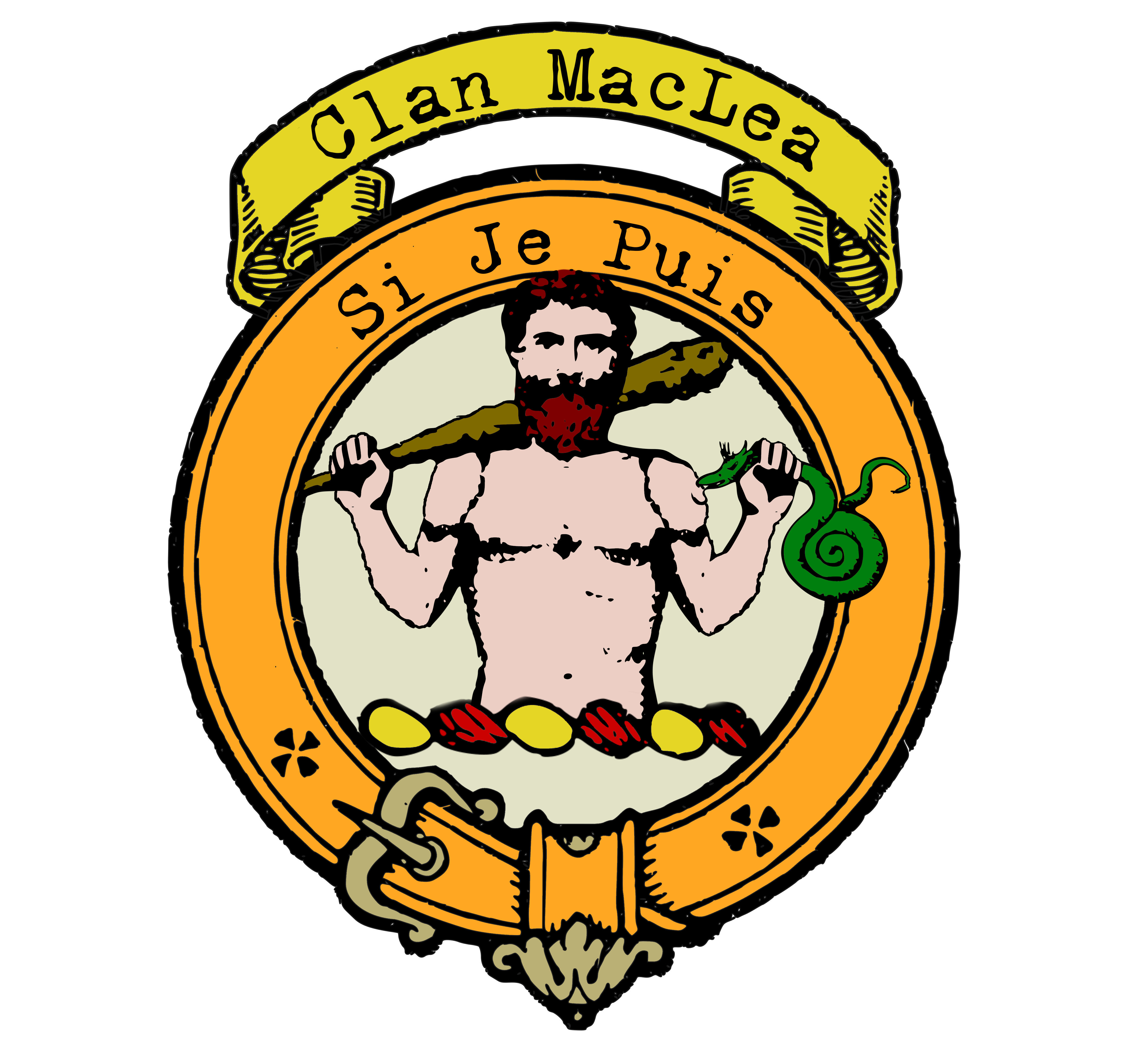Clan MacLea Crest
|
|
CREST: A demi savage, wreathed about the head and middle with laurel, Vert holding on his dexter shoulder a club, and in his sinister hand a serpent bowed. MOTTO: Si Je puis TRANSLATION: If I can VARIATIONS: Livingstone |
| The origins of Clan MacLea, also known as the Highland Livingstones, can be traced to the district of Lorn in Argyll, Scotland. Situated on the picturesque Isle of Lismore, the clan has a deep connection to this enchanting land. The name MacLea has multiple possible origins and etymologies, leading to differing theories among historians.
One theory suggests that the name MacLea is derived from the patronymic Mac Dhunnshleibhe, meaning “son of Donn Sléibhe” or “son of the brown-haired chieftain of the mountain.” This theory emphasizes the clan’s ties to the rugged Highland landscapes and their ancestral heritage. Another theory proposes that MacLea is an Anglicized version of Mac an Léigh, a Gaelic nickname surname meaning “son of the physician.” This theory hints at a potential connection to ancient medical families in Ireland, adding another layer of complexity to the clan’s history. |
|
 |
|
| Purchase @ Redbubble Purchase @ Amazon.com Purchase @ Amazon.co.uk |
|
| One of the defining aspects of Clan MacLea’s history is their association with Saint Moluag, a Scottish missionary who evangelized the Picts during the sixth century. The Coarbs of Saint Moluag, the hereditary keepers of his pastoral staff, played a significant role within the clan. The Great Staff of Saint Moluag, also known as Bachuil Mor, is believed to be the sixth-century saint’s crozier.
The Coarbs, recognized by the Lord Lyon, were viewed as the successors of Saint Moluag, carrying forward his legacy. Their connection to Saint Moluag granted them a unique position within Scottish society, with the Coarb being considered a sovereign baron. This prestigious role was accompanied by a distinct Coat of Arms, featuring the Cap of Maintenance of Gules doubled Vair, symbolizing their status. Clan MacLea’s lineage extends beyond the boundaries of Scotland. Some historians propose a connection between the MacLeas and the ancient kings of Ulidia, particularly Ruaidhri Mac Duinnsleibhe, the last king of Ulidia. This link further highlights the clan’s prominent position within Irish and Scottish history. Furthermore, the MacLeas are believed to be descendants of Cu-Uladh, son of the last MacDunshleibe King of Ulidia. It is suggested that, following the English invasion of Ireland, descendants of this family migrated to Scotland, where they adopted the name Livingstone and MacLea. Throughout their history, Clan MacLea faced numerous challenges and demonstrated their unwavering loyalty to their heritage. During the Scottish Civil War of the 17th century, they remained loyal to the Crown, resulting in the loss of their estates at the hands of the Scottish Covenanters and later, Oliver Cromwell’s Parliamentarians. In the 18th century, the clan supported the Jacobite rising of 1715, resulting in the forfeiture of their titles. However, their commitment to their cause was evident as MacLeas, later referred to as Livingstones, fought valiantly in the Appin Regiment during the decisive Battle of Culloden in 1746. Notably, Donald Livingstone of Bun-a-mhuilinn, Morvern, played a pivotal role in saving the Appin Standard during the battle. Clan MacLea’s history is also punctuated by several clan battles, showcasing their resilience and determination. The Battle of Bealach na Broige stands as a testament to their fierce nature, as MacLeas, along with other north-western highland clans, clashed with the Earl of Ross and his followers. Although the battle ended in defeat, the bravery and spirit of the MacLeas were evident. In another significant conflict, the McLeays of Achnacree suffered heavy losses, with 80 men falling in support of the MacDougalls of Lorn against the Clan Campbell of Inverawe. The Dunaverty Massacre further highlighted the MacLeas’ loyalty to their allies, the MacDougalls, even at great personal cost. Despite their ancient heritage, Clan MacLea was not formally recognized by the Lord Lyon until 2003. It was during this time that William Jervis Alastair Livingstone of Bachuil became the first recognized clan chief. His dedication to preserving the clan’s legacy and representing their interests led him to become a member of the Standing Council of Scottish Chiefs. |
|
Citations:
|
|

